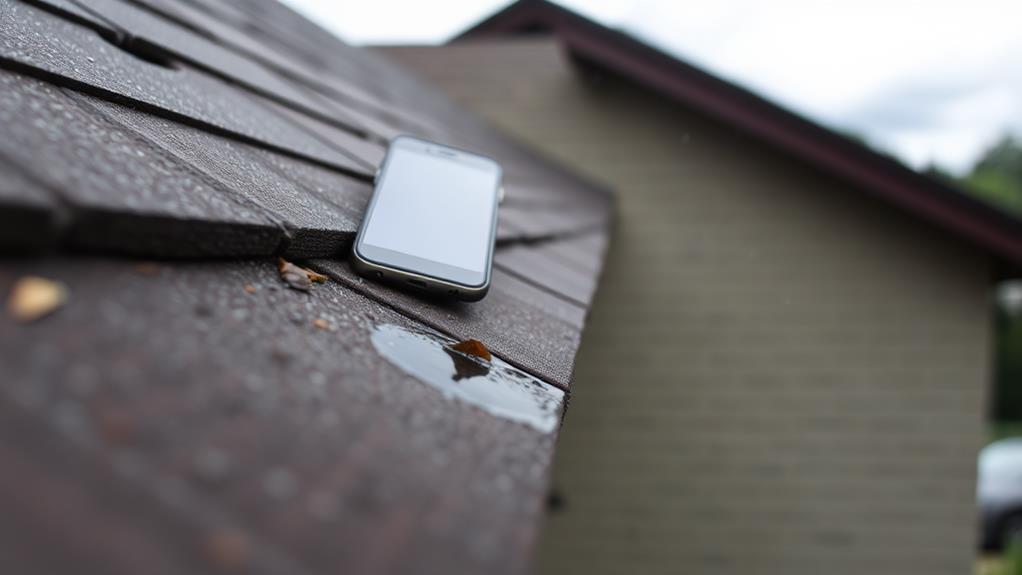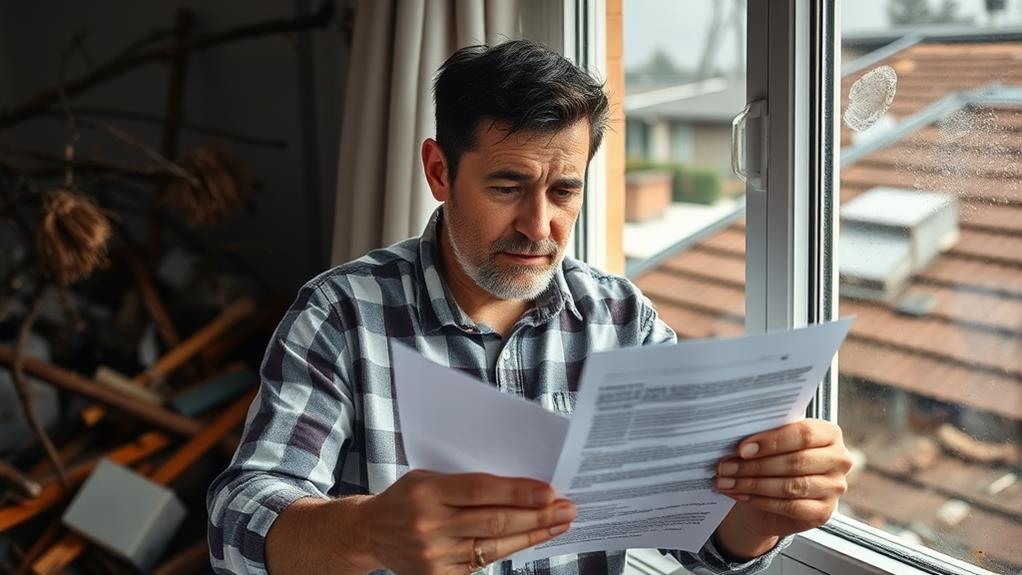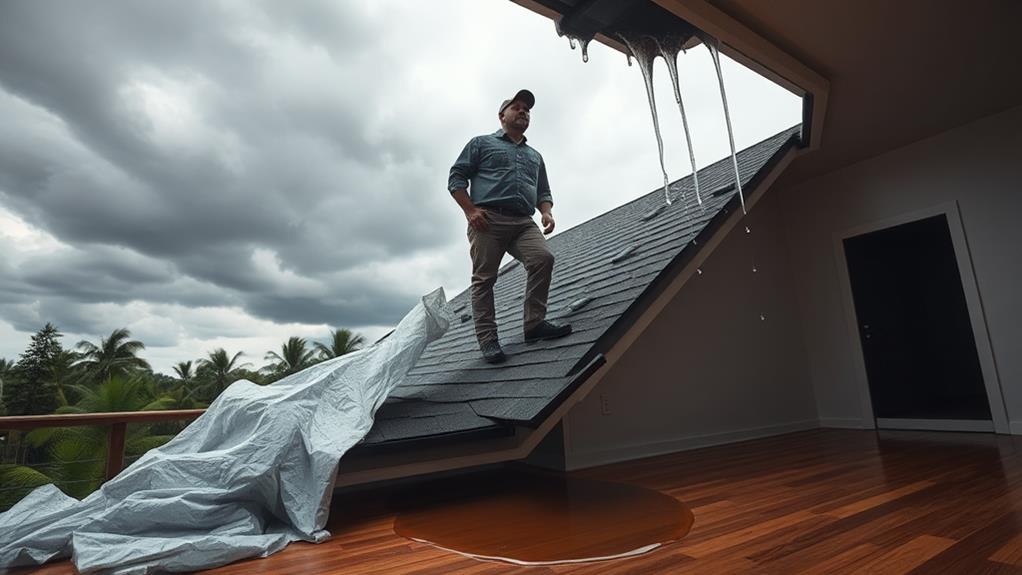Common mistakes homeowners make when assessing storm damage include overlooking hidden issues, rushing the assessment process, and neglecting proper documentation. Many fail to recognize concealed problems like water damage to attics or foundation issues. Skipping professional inspections and misunderstanding insurance coverage can lead to costly oversights. Ignoring safety precautions and delaying temporary repairs may exacerbate damage and create hazardous conditions. Homeowners often hire unqualified contractors, risking substandard repairs and potential legal issues. Proper assessment requires attention to detail, thorough documentation, and expert guidance. By avoiding these pitfalls, homeowners can better protect their property and ensure fair compensation for storm-related damages.
Overlooking Hidden Damage

Storm-ravaged homes often harbor concealed issues that homeowners frequently miss during initial assessments. These hidden damages can lead to more severe problems if left unaddressed, potentially compromising the structural integrity of the house and increasing repair costs over time.
One common oversight is attic damage. Wind-driven rain can penetrate roof shingles, causing water damage to insulation and wooden structures. Similarly, foundation issues may arise from excessive water accumulation around the house's perimeter, leading to cracks or shifts that are not immediately visible.
Electrical systems are another area prone to hidden storm damage. Water infiltration can corrode wiring and junction boxes, creating fire hazards. Plumbing systems may also suffer from subtle leaks or displacement due to ground shifting or falling debris.
Homeowners often neglect to inspect chimneys and vents, which can sustain damage from high winds or flying debris. Blocked or damaged vents can lead to improper ventilation and potential carbon monoxide buildup.
To avoid overlooking these hidden issues, it's crucial for homeowners to conduct thorough inspections, including less accessible areas of the property. Engaging professional assessors can help identify concealed damage that might otherwise go unnoticed, ensuring comprehensive repairs and maintaining the home's long-term safety and value.
Rushing the Assessment Process
Many homeowners, eager to return to normalcy after a storm, make the critical error of rushing through the damage assessment process. This haste can lead to overlooking significant issues, potentially resulting in more extensive and costly repairs down the line. A thorough assessment requires time and patience to identify all areas affected by the storm.
Rushing the process may cause homeowners to miss subtle signs of damage, such as small leaks, minor structural shifts, or developing mold problems. These issues, if left unaddressed, can escalate into major problems that compromise the integrity and safety of the home. Additionally, a hasty assessment may lead to inaccurate documentation, which can affect insurance claims and reimbursements.
To avoid these pitfalls, homeowners should take a systematic approach to damage assessment. This includes carefully inspecting both the exterior and interior of the property, documenting all findings with photographs and detailed notes, and consulting with professionals when necessary. It's essential to remember that some damage may not be immediately apparent and may require multiple inspections over time to fully reveal itself. Prioritizing a comprehensive assessment over speed ensures that all storm-related issues are properly identified and addressed.
Neglecting Proper Documentation

A common pitfall for homeowners when assessing storm damage is neglecting proper documentation. This oversight can significantly impact insurance claims and potential reimbursements. Proper documentation involves a systematic approach to recording all visible damage, including photographs, videos, and detailed written descriptions.
Homeowners should start by capturing wide-angle shots of affected areas, followed by close-up images of specific damage points. It's crucial to document the date and time of the damage, as well as any temporary repairs made to prevent further destruction. Keeping receipts for emergency supplies or services is also essential.
Many homeowners fail to document pre-existing conditions, which can lead to disputes with insurance adjusters. Creating a home inventory before storm season and updating it regularly can provide valuable evidence of property condition and value. Additionally, recording conversations with insurance representatives, contractors, and other relevant parties can help prevent misunderstandings and protect homeowners' interests.
Neglecting proper documentation can result in delayed or denied claims, undervalued settlements, and prolonged disputes. By maintaining thorough records, homeowners can streamline the claims process and increase their chances of fair compensation for storm damage.
Skipping Professional Inspections
While homeowners may feel confident in their ability to assess storm damage, skipping professional inspections is a critical mistake that can have far-reaching consequences. Trained professionals possess the expertise to identify subtle signs of damage that may not be immediately apparent to the untrained eye. These hidden issues, if left unaddressed, can lead to more severe problems and costly repairs down the line.
Professional inspectors use specialized equipment and techniques to thoroughly examine a property's structure, including roofs, foundations, and electrical systems. They can detect water intrusion, structural weaknesses, and potential safety hazards that homeowners might overlook. Additionally, insurance companies often require professional assessments to process claims accurately.
Misunderstanding Insurance Coverage

Beyond the importance of professional inspections, homeowners often encounter challenges when dealing with their insurance coverage after storm damage. A common mistake is assuming that all storm-related damage is automatically covered by their policy. In reality, coverage can vary significantly depending on the specific type of damage and the policy's terms.
Many homeowners fail to thoroughly review their insurance policies before a storm occurs, leaving them unprepared for potential coverage gaps. For instance, flood damage is typically not covered by standard homeowners insurance and requires a separate policy. Additionally, some policies may have specific exclusions for certain types of wind damage or may limit coverage for roof repairs.
Another frequent misunderstanding is the difference between actual cash value and replacement cost coverage. Actual cash value accounts for depreciation, potentially leaving homeowners with insufficient funds for full repairs. Replacement cost coverage, while often more expensive, provides better protection against storm damage.
Homeowners should also be aware of their policy's deductible, which may be higher for storm-related claims. Misunderstanding these details can lead to unexpected out-of-pocket expenses and frustration during the claims process.
Ignoring Safety Precautions
When assessing storm damage, homeowners often overlook crucial safety precautions, putting themselves and others at risk. In their eagerness to evaluate and document damage, many fail to consider potential hazards like unstable structures, exposed electrical wires, or weakened trees.
One common mistake is entering damaged buildings without proper inspection. Compromised foundations, walls, or roofs can collapse unexpectedly, causing severe injuries. Additionally, homeowners may underestimate the dangers of downed power lines, assuming they are inactive when they could still be energized.
Water damage presents another set of risks, including electrocution hazards and exposure to harmful contaminants. Floodwaters often contain sewage, chemicals, and debris, posing serious health risks if proper protective gear isn't worn.
Homeowners should also be wary of using equipment they're unfamiliar with, such as chainsaws or generators, without proper training. Mishandling these tools can lead to accidents or carbon monoxide poisoning.
To ensure safety, it's crucial to wait for professional assessments before entering damaged areas. Wearing appropriate protective gear, such as hard hats, gloves, and sturdy boots, is essential. Homeowners should also be aware of potential gas leaks and avoid using open flames or electrical devices in affected areas until cleared by experts.
Delaying Temporary Repairs

After a storm, many homeowners make the critical mistake of delaying temporary repairs. This oversight can lead to significant secondary damage, exacerbating the initial problems caused by the storm. Water infiltration through damaged roofs, broken windows, or compromised siding can result in mold growth, structural weakening, and electrical hazards if left unaddressed.
Temporary repairs, such as covering roof damage with tarps, boarding up broken windows, or sealing leaks, are crucial in preventing further deterioration of the property. These quick fixes can protect the home's interior from additional water damage, pest intrusion, and exposure to the elements. Moreover, insurance companies often require policyholders to take reasonable steps to mitigate further damage, and failing to do so may result in reduced claim payouts or denied coverage.
Homeowners should prioritize temporary repairs as soon as it is safe to do so after a storm. Keep essential supplies on hand, including tarps, plywood, nails, and duct tape, to quickly address immediate concerns. While these measures are not permanent solutions, they can effectively safeguard the property until professional repairs can be undertaken, potentially saving thousands of dollars in additional damage and restoration costs.
Hiring Unqualified Contractors
In the aftermath of a storm, desperate homeowners often fall prey to unqualified contractors who promise quick repairs at attractive prices. These opportunistic individuals may lack proper licensing, insurance, or the necessary skills to perform quality work. Hiring such contractors can lead to substandard repairs, further property damage, and potential legal issues.
To avoid this mistake, homeowners should thoroughly research and vet potential contractors before hiring. Verify credentials, including licenses and insurance coverage, and request references from previous clients. Reputable contractors will provide detailed written estimates and contracts outlining the scope of work, materials to be used, and project timelines.
Be wary of contractors who demand large upfront payments or pressure you to sign contracts immediately. Legitimate professionals understand the importance of allowing homeowners time to review agreements and compare quotes. Additionally, check with local building authorities to ensure the contractor pulls necessary permits for the work.
Consider working with contractors who are certified by reputable industry organizations or recommended by your insurance company. These professionals are more likely to adhere to industry standards and building codes, ensuring that repairs are completed correctly and safely.
Frequently Asked Questions
How Long Do I Have to File a Storm Damage Claim?
The timeframe for filing a storm damage claim varies by insurance provider and policy terms. Generally, it's advisable to file as soon as possible, typically within 30 to 60 days after the incident, to ensure timely processing and coverage.
Can I Make Repairs Before the Insurance Adjuster Arrives?
While it's advisable to prevent further damage, avoid making permanent repairs before the adjuster's assessment. You can take temporary measures to protect your property, but document everything with photos and keep all receipts for reimbursement purposes.
What Tools Should I Have on Hand for Assessing Storm Damage?
In the face of Mother Nature's wrath, be prepared! Essential tools for assessing storm damage include a flashlight, camera, tape measure, notepad, and binoculars. Safety gear like gloves and a hard hat are also crucial for thorough inspections.
Are There Specific Weather Conditions That Increase the Risk of Storm Damage?
Several weather conditions heighten storm damage risk, including high winds, heavy rainfall, hail, lightning strikes, and rapid temperature fluctuations. Coastal areas face additional threats from storm surges and hurricanes. Extended periods of extreme weather also increase vulnerability to damage.
How Often Should I Inspect My Roof for Potential Storm Damage?
While it's tempting to adopt an "out of sight, out of mind" approach, vigilance is key. Experts recommend inspecting your roof biannually, typically in spring and fall, and after any significant weather events to ensure its integrity and longevity.
Conclusion
Avoiding common mistakes in storm damage assessment is crucial for homeowners. By being thorough, patient, and diligent, property owners can ensure accurate evaluations, proper documentation, and appropriate insurance claims. Prioritizing safety, seeking professional inspections, and understanding coverage details are essential steps. Timely temporary repairs and careful contractor selection further safeguard against additional damage and financial loss. Ultimately, a methodical, informed approach to storm damage assessment protects both the property and the homeowner's interests.

